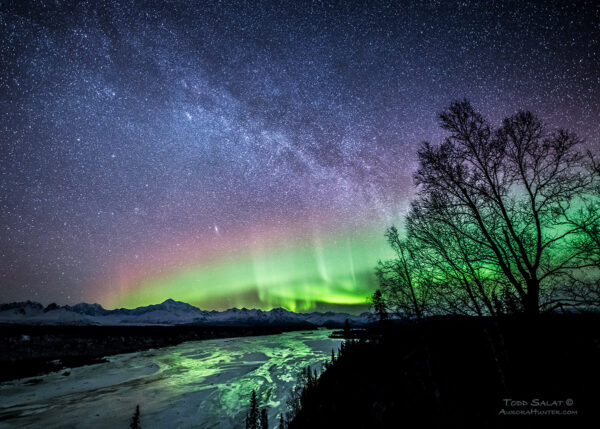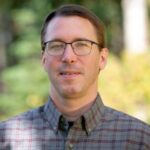
It’s the darkest time of year in Alaska, which means plenty of hours for aurora hunting, weather permitting of course.
And among those night owls casting their gaze heavenward each night is professional aurora photographer Todd Salat.
Salat has spent many winters with an inverted schedule from most people, waking up at night hoping for a glimpse of the green, purple or even red of the northern lights on the horizon.
Salat says, what had been an amateur’s passion for aurora photography, became a real job 25 years ago.
Listen here:
[Sign up for Alaska Public Media’s daily newsletter to get our top stories delivered to your inbox.]
The following transcript has been lightly edited for clarity.
Todd Salat: So I was moonlighting as an aurora hunter, while staying up all night and then getting a couple hours asleep, and then clocking on to my day job, exploring for oil. And I enjoyed my time as a geologist tremendously. But then what happens in the oil industry, sometimes you get lay off sessions and the boom and the bust cycles, and that was when I decided to take the plunge, and I resigned from my day job. I traveled the world for a year, grew my hair and then in ’97, I came back as a full-time aurora hunter.
Casey Grove: What’s it actually like? I mean, what does this look like for you day in and day out? I guess I should say night in night out. How do you approach it? You know, how do you get these shots?
TS: It is a lifestyle, I would have to say. I cannot go to bed before 3 or 4 a.m. I can try. But I’ll just lie there awake. So I just look every single night of my life. I look out to the north. And, you know, check the weather. See if we have clear Earth weather. And then I have to pay a little bit closer attention, especially if I’m here in town in Anchorage, it’s a lot harder when I’m in town. But when I’m out there, aurora hunting, I have a camper, a pop-up camper on top of my truck. And then I’m just totally in the zone. I’m in the rhythm of nature, if you will. So I’m just living with the stars and the moon and the mountains, and the lighting and the weather. And that’s my favorite place to be. But in the end, I always say, you got to have eyes on the sky to really see and experience the northern lights. You got to see a little green band coming in, you know, maybe that’s 11 p.m. or midnight, and then watch it throughout the night. Because those are auroras come on with such a burst at times that if you’re not on top of it, you can just miss the the grandiose moment of the night, which might only last 15 minutes.
CG: In what ways is aurora photography technically different than other types of photography?
TS: It’s critical to have a tripod. So it’s not really a point and shoot. Although, these days with smartphones, you can get a pretty decent shot just by a handheld, you know, and nighttime mode. But when you go to blow that picture up beyond anything than an 8 by 10 print, it might probably get noisy or grainy. So having a tripod is critical, then I go always go into manual mode on my camera. So I can set my F-stop and aperture pretty close to wide open, meaning I want as much light to come through my lens as possible. Then I’ll crank up the ISO on my digital camera, you know, 10, 15 years ago I went from film to digital. So these days, I’ll turn up my ISO to 1600, maybe even 3200, very sensitive sensor to record the auroras. And then the third main ingredient is doing an exposure time of several seconds. If the auroras are really bright, it might be only a one- or two-second exposure, if the moon’s out, but if there’s no moon and the auroras are dim, you might do a 15-second exposure and just let that light burn in on your camera. So it’s a big experiment and going digital these days where you can look on the back of your camera and see if you got the auroras being preserved, captured, recorded with your camera, it’s great instant feedback. And then you just got to make all your adjustments to get it you know, just right.
CG: One thing I wanted to ask you, because we’ve been asking a lot of folks this the last couple of years, has the pandemic affected your job?
TS: The nice part about being an aurora hunter, in the middle of the night, IS social distancing is literally my forte. I would go out for a week and not talk to anybody, on a good year. So, you know, I pull into a gas station in the middle of the night and then go on and not seeing anybody for days on end. Now, the summer markets last year, the Anchorage Market and festival that was downtown then, you know, it took a beating pretty bad because it just wasn’t happening. But then come along the holidays last year, people were starting to get used to wearing their, you know, the masks and stuff, which were mandatory at that time in the mall. And we had one of the best holiday seasons last year, Christmas of 2020, in 10 years. So it was stunning, the way people would come out of the woodwork and support us. It was enlightening, In this lifestyle when you’re self-employed, and as I like to say you start every day at a goose egg, it is very rewarding.
Casey Grove is host of Alaska News Nightly, a general assignment reporter and an editor at Alaska Public Media. Reach him at cgrove@alaskapublic.org. Read more about Casey here.





